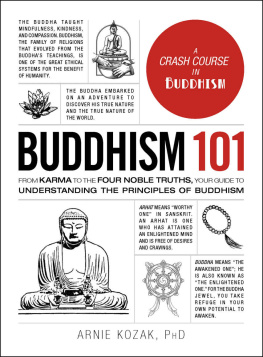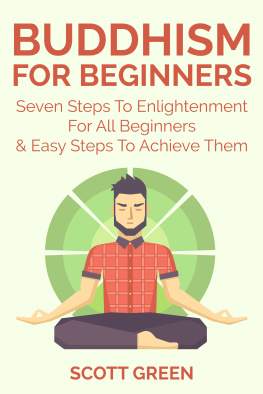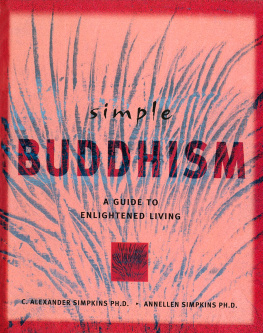Thank you for downloading this Simon & Schuster ebook.
Get a FREE ebook when you join our mailing list. Plus, get updates on new releases, deals, recommended reads, and more from Simon & Schuster. Click below to sign up and see terms and conditions.
CLICK HERE TO SIGN UP
Already a subscriber? Provide your email again so we can register this ebook and send you more of what you like to read. You will continue to receive exclusive offers in your inbox.
CONTENTS
INTRODUCTION
Buddhism, one of the worlds five great religions, has upward of 500 million followers worldwide. The wisdom that Buddhism has accumulated in its 2,500 years of existence still transforms lives today, as it did in ancient India where it originated.
A contemporary translation of the beloved poetry volume, the Dhammapada , by Gil Fronsdal, starts with these words, All experience is preceded by mind, led by mind, made by mind. This idea is at the heart of Buddhism. Buddhists practice mindfulness and compassion in all they do.
The Buddha was an Indian prince, Siddhartha Gotama. Although he lived in pampered luxury, he recognized that everything we see around usincluding ourselveswill pass away. By prolonged meditation on this he realized that to achieve happiness we must put aside desire for the things of this world, both material and immaterial. Buddhism identifies the three most valuable things in life:
Buddha everyones potential for awakening
Dharma the collection of the Buddhas teachings
Sangha the community of practitioners
The path to freedom is realized by practicing the Noble Eightfold Path, eight disciplines (view, resolve, speech, action, livelihood, effort, mindfulness, and concentration) through which a practitioner can achieve cessation of suffering, a condition Buddhists call nirvana .
Buddhism 101 will introduce you to this religious tradition. Youll learn the basic principles of Buddhism and the various Buddhist traditions, ranging from Zen Buddhism in Japan to Tibetan Buddhism, practiced in temples high in the majestic Himalayas. Youll see that although theres a core set of beliefs common to all Buddhists, there is not a single Buddhism; instead, there are a wide variety of Buddhist beliefs and practices, depending on the country and tradition.
Today, Buddhism is spreading in the West and provides a way to look at many of the challenges that face society. You may already be familiar withand even engage insome Buddhist practices such as meditation and mindfulness without even realizing where these practices came from.
Whether youre interested in the origins of Buddhism, the nature of its practices, or if you want to find out how you can begin to live a mindful life filled with lovingkindness, Buddhism 101 will answer your questions.
Happiness, says the Dalai Lama, spiritual leader of Tibetan Buddhism, is not something ready made. It comes from your own actions. In Buddhism 101 youll learn more about this way of looking at the world and discover how those who practice Buddhism create their own happiness and find inner peace.
WHAT IS BUDDHISM?
Religion or Philosophy?
Buddhism is one of the worlds great religions. Behind Christianity, Islam, and Hinduism, it is the fourth most followed religion in the world. The question might be raised: Is Buddhism a religion at all?
RELIGION OR PHILOSOPHY?
Can you have a religion without god, a supreme being that created the world and intervenes in the lives of his (or her) creatures? It appears that Buddhism can be considered a nontheistic religion, according to Buddhist scholar Damien Keown, when it is considered along seven dimensions common to religion. These seven dimensions include:
Practical and Ritual
Experiential and Emotional
Narrative and Mythic
Doctrinal and Philosophical
Ethical and Legal
Social and Institutional
Material
Practical and Ritual
While the ritual elements of Buddhism may seem bare bones compared to the Catholic Church, for example, Buddhism certainly has rites and rituals that are public and private, many of which are associated with monastic life. Different Buddhist traditions place different emphasis on ritual.
Experiential and Emotional
The experiential dimension is the most important dimension of Buddhism. The Buddha was the exemplar. He transformed his life not through belief but through experiential practice. The heart of Buddhist practice is to be experienced rather than believed.
Narrative and Mythic
Buddhism is not without its myths and legends, including those surrounding the life of the Buddha, which can be read as a parable as well as a biographical account of the historical figure known as Siddhartha Gotama. There are many narrative elements in Buddhism, including the Jataka tales. Indeed, even the name Siddhartha is part of the mythologyan honorific title added centuries after his death.
Doctrinal and Philosophical
Professor Keown says of doctrine, if by doctrine we understand the systematic formulation of religious teachings in an intellectually coherent form, then Buddhism qualifies as having doctrine in this sense. For example, the Four Noble Truths are the foundation of the Buddhas teachings.
Ethical and Legal
Buddhism is widely regarded as one of the worlds most ethical religions, having incorporated ethics into the foundation of the experiential practices. The central ethic is to do no harm. Buddhism is predominately a path of peace. For example, the Dalai Lama has consistently advocated peaceful resistance to the Chinese occupation of his country, an occupation that has, by some estimates, claimed a million lives and destroyed 6,000 monasteries.
Social and Institutional
The sangha is the community of Buddhist practitioners, and it is one of humanitys oldest continuous institutions. Yet the sangha is not an institution in the sense that it has a central authority such as the Vatican. It is a diverse collection of people across nations and cultures that practice the Buddhas teachings in diverse ways. Buddhism is a socially engaged religion seeking to make positive changes in society.
Material
Buddhists have built breathtaking monasteries, caves, and carvings of the Buddha. King Ashoka left a legacy of stupas (dome-shaped structures) across India. Buddhist art is colorful and narrative. Buddhists make pilgrimages to holy sites such as the birth and death place of the Buddha and the places where he became enlightened and gave his first sermon.
As you can see, while Buddhism does not have a god and the Buddha is not regarded as a god, it fulfills the other criteria for a religion. You can adopt Buddhism as your religion or you can regard it as a set of experiential practices, such as meditation, that you can integrate with your own religious beliefs. Or, as many do, you can approach Buddhism in an entirely secular manner, as a philosophical system for living, eschewing all rituals, beliefs, and doctrine, just as the Buddha did 2,500 years ago in his search for a way to end suffering. You, just like the Buddha, have the same potential for awakening.
BUDDHA VERSUS BUDDHISM
Throughout this book a distinction will be made between the Buddha (the life and teachings of Siddhartha Gotama) and Buddhism (the religious institutions that have developed over the past 2,500 years in many different parts of the world). Not all Buddhism is Buddha, as these social organizations have migrated and developed over the centuries.





![Dalaï Lama XIV. - An introduction to Buddhism: [teachings on the Four noble truths, The eight verses on training the mind and the Lamp for the path to enlightenment]](/uploads/posts/book/207935/thumbs/dala-lama-xiv-an-introduction-to-buddhism.jpg)



